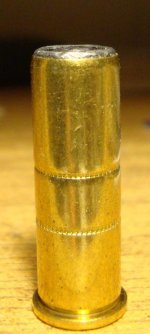My recipe
Mixed brass
W231 2.9 grains
Prec Delta 148 grn HBWC
Win SPP
No trimming or uniforming of cases. All rounds fed/fired without issue which is something I cant claim with the factory ammo I have fired.
My group would have been great if it was from any of my other guns but I have come to expect more from my 52-2. There was a noticeable group and the xring was gone but there were more single rounds outside the group than has occured with factory ammo.
Are expectations good that the group will tighten with another tenth of a grain or two?
I'm not shooting bullseye comp with this gun, just plinking. My ammo expectation is to make a round that works as good as I can hope for with this gun (it prefers factory) but I can still use it in my .38 revolvers for fun shooting.
Mixed brass
W231 2.9 grains
Prec Delta 148 grn HBWC
Win SPP
No trimming or uniforming of cases. All rounds fed/fired without issue which is something I cant claim with the factory ammo I have fired.
My group would have been great if it was from any of my other guns but I have come to expect more from my 52-2. There was a noticeable group and the xring was gone but there were more single rounds outside the group than has occured with factory ammo.
Are expectations good that the group will tighten with another tenth of a grain or two?
I'm not shooting bullseye comp with this gun, just plinking. My ammo expectation is to make a round that works as good as I can hope for with this gun (it prefers factory) but I can still use it in my .38 revolvers for fun shooting.





